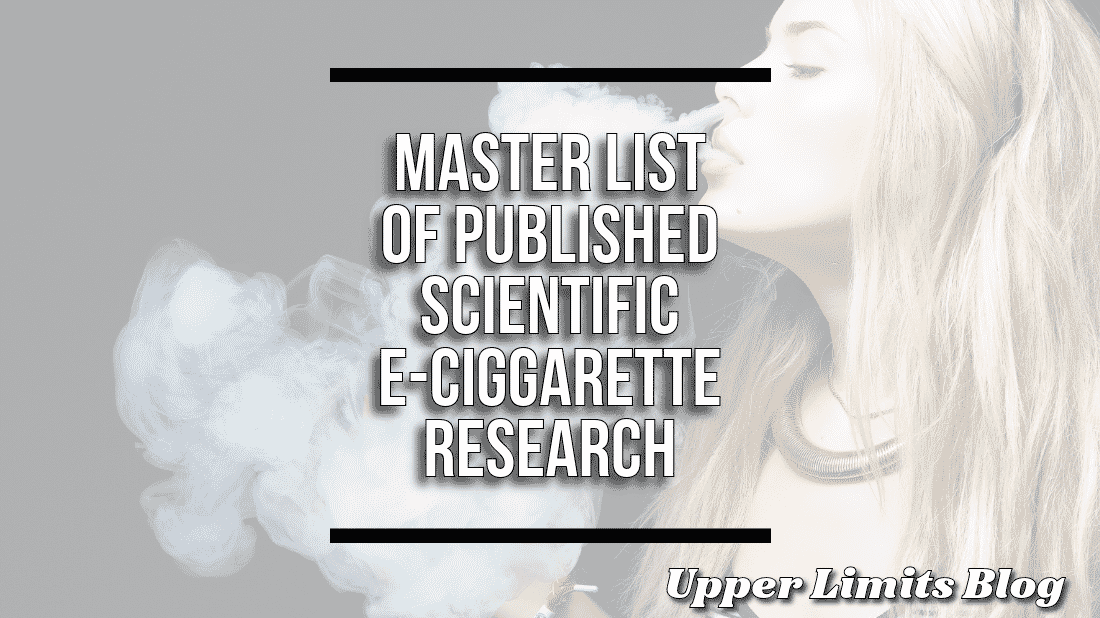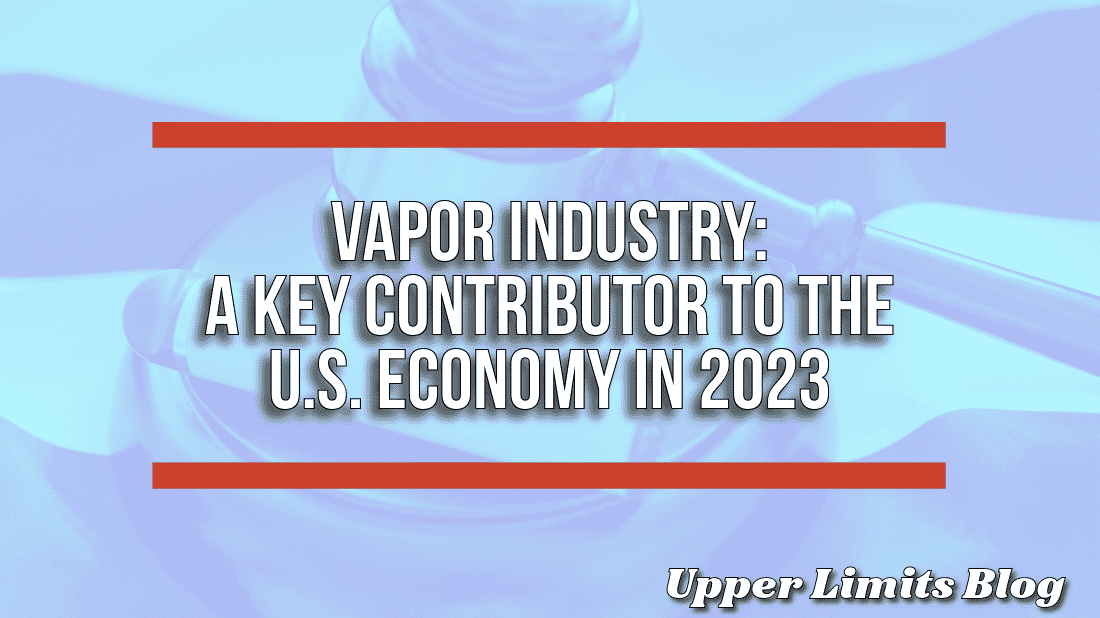Vaping vs. Cigarettes: Everything I Learned In 2 Weeks Of Research

Vaping vs. Cigarettes: Everything I learned in 2 weeks after reading all the studies I found.
Source: https://www.reddit.com/r/electronic_cigarette/
By: Rweegy
This is a very long post, and I apologize in advance. It has good title separation, so please feel free to skip and jump around. This is a repost of my own post in r/Vaping*.*
It’s been over a month since I put out my last cigarette after ten years of smoking.
Vaping helped me the most in this transition, but my obsessive nature got me to research the living hell of this topic.
Information was scattered all over the web, and I couldn't find a single conclusive article on the matter, so I set out to write the article I was looking for. (scratch your own itch?)
This post has about 50 links for further reading. None bring me or any other party any monetary gain. The wonderful community of Reddit helped me a lot with this research, so I just want to give back.
Enjoy!
What is Vape Juice Made Of?
Vape juice consists of 4 ingredients:
- Propylene Glycol (PG)
- Vegetable Glycerin (VG)
- Flavorings (?)
- Nicotine (optional)
Cigarettes -mainly- consist of 19 ingredients:
- Nicotine
- Citric acid
- Tar
- Ammonia
- Glycerol
- Benzyl alcohol
- Caffeine
- Benzaldehyde
- Butyric acid
- Acetylpyrazine
- Oil
- Acetanisole
- Carbon dioxide
- Cinnamaldehyde
- Cinnamyl alcohol
- Lactic acid
- Anisyl acetate
- Citronella oil
- Cinnamyl acetate
In addition, in 1994, big tobacco companies were forced by law to disclose any additives they put in, extending this list by another 599 known additives.
The smoke of cigarettes, however, is a different story.
In one study, cigarette smoke produces over 5000 chemicals. 2,256 of which are known and studied. 98 were assessed for their risk value: 60 carcinogens (potential to cause cancer) and 48 non-cancerous (definitely not vitamins, though)
On the other hand, In a 2021 study, vaping produced about 2000 chemicals that are largely unidentified, with “some” being “potentially” harmful.
Unidentified is not the same as safe.
But from a common sense perspective, cigarette smoke is far more complex due mainly to the nasty combustion process.
My method here is to analyze the most abundant and known harmful chemicals in vaping and cigarettes.
“The Dose Makes The Poison” — Paracelsus ca. 1540
Sure, I love to get philosophical on you every chance I get. But here, I find it mandatory. It’s the motto. Keep it in mind while reading everything below.
“Enough” water can kill you, and “some” black mamba venom can cure you.
Let’s dig deep:
1. Nicotine — The unjustified bad rep
Oh boy... I wasn’t ready for this.
According to the National Health Service of the UK, Nicotine, although a very addictive substance, is still relatively harmless.
Nictoine’s lousy rep stems from its association in our minds with cigarettes.
It’s a stimulant that increases alertness, focus, and concentration. It also improves cognitive function and fine motor skills and enhances short-term memory.
But its recorded benefits are far from just that!
A study of 220,494 people aged 37–70 study recognized a strange protective link to Parkinson’s disease. The results made my jaw drop:
- A 20% reduction in the likelihood of developing Parkinson's in former smokers.
- A 50% reduction in the likelihood of developing Parkinson's for current smokers.
Parkinson's affects 7–14 million people worldwide. This unexpected preventive quality of nicotine can affect the lives of millions.
Millions that otherwise have no cure.
This beautiful article from Dr. Katherine Fletcher takes a deep dive into this relationship.
In terms of dose, a study compared nicotine absorption from vaping an 18 mg/ml juice vs. cigarettes and found that:
“Compared to smoking one tobacco cigarette, the EC devices and liquid used in this study delivered one-third to one-fourth the amount of nicotine after 5 minutes of use”
For reference, 12–18mg/ml is recommended for those who smoke 15–20 cigarettes daily.
Note that Nicotine is still very addictive since it activates the neuropathways of reward, causing dependence and cravings. It also causes a temporary increase in heart rate and blood pressure.
2. Formaldehyde (Methanal)
It is a colorless, corrosive, awfully smelling, and potentially carcinogenic gas at room temperature.
It’s the building block of many industrial processes, and it’s found practically everywhere.
Humans, plants and practically any organic living matter emit Methanal. It’s a byproduct of metabolism. It’s abundant in cigarettes since burning is an extreme form of metabolism.
For every potentially hazardous chemical, there is an occupational exposure limit (legal concentration limits in a workplace) according to the Occupational Safety and Health Administration
- The daily maximum exposure to Formaldehyde is 5.3 mg.
- A pack of cigarettes contains about 1.5–2.5 mg of Formaldehyde.
- 3g of e-liquid contained 0.04-22 mg (*)
3. Acetaldehyde (Ethanal) — The hungover chemical
is a clear, colorless liquid with a pungent choking odor most abundant in tobacco products.
Also, a member of the aldehyde family like Formaldehyde.
This is the toxic byproduct of metabolizing alcohol found in your liver after a heavy night of drinking. It’s also one of the reasons why we get hungover.
This compound is carcinogenic in animals and potentially so in humans due to its irreversible DNA damage properties.
Dosage Comparations:
- The daily maximum exposure to Acetaldehyde is 2088 mg.
- A pack of cigarettes contains about 10–30 mg of Acetaldehyde.
- 3g of e-liquid had 0.02–17 mg(*) of Acetaldehyde
4. Acrolein
Acrolein is a colorless to yellowish liquid with a pungent and irritating odor.
It’s so irritating that they use it to make tear gas and herbicides.
Just like the other two compounds above, it too falls under the umbrella of “aldehydes,” making it a byproduct of the decomposition of organic matter.
In animal studies, prolonged exposure to acrolein has been associated with lung and oral cancer, but the evidence is limited in humans. It is also linked with heart disease in cigarettes.
- The daily maximum exposure to Acrolein is 1.5 mg.
- A pack of cigarettes contains about 1.5–3 mg of Acrolein.
- 3g of e-liquid contained <0.003–2.4 mg(*) of Acrolein
5. Diacetyl (Flavouring)
*This chemical has been banned in the EU and the UK from E-cigarette juice since 2016. Never buy your juice from shady sources/brands.
But the media made sure to make a big deal out of it.
Diacetyl is an organic compound that packs an intense buttery aroma and flavor and is used in alcoholic beverages, some desserts, and e-liquids.
This buttery flavoring agent is said to cause a disease called “Popcorn Lungs.”
Popcorn lungs is when the tiny airways of the lungs get micro scares that cause these pathways to inflam and thus reduce and decrease air flow rate.
The myth goes as follows:
A long time ago, 11 workers in a popcorn factory had respiratory illness. The investigators thought it could be due to the daily Diacetyl they were exposed to.
But no further investigation has been made.
To date, there are ZERO cases of Popcorn lungs that have been linked to Vaping.
A Harvard study found 9.0 micrograms of Diacetyl in some E-juice, aside from the real risks of Diacetyl. Cigarette smoke contained way more than that.
It's way way more.
A study found 301–433 micrograms of Diacetyl per cigarette. Converted to parts per million parts of air (ppm) (assuming a weight of 700 milligrams per cigarette), it’s 429 ppm**.**
What is the safe limit of short-term acute (15 mins) exposure to Diacetyl, you ask?
It is 100 ppm!
That makes the daily exposure to Diacetyl from smoking 750 times higher, on average, than exposure to Diacetyl from vaping.
6. Heavy Toxic Metals — Vague... Super Vague...
I hit a big fat wall here.
Not only was this too complex for me to understand, but most of the studies in this area showed no relevant information on the coil material and devices used.
Worse still, some of these studies I discovered were industry-funded.
It got frustrating fast. I had to start all over multiple times. Throughout the 15 years of e-cig evolution, many coil materials, temperatures, and devices came and went.
Some of these old studies found dangerously high copper, nickel and silver levels. While a report from the Royal College of Physicians in the UK found the concentration of heavy metals “Not a major concern because levels of exposure are well below recognized safety thresholds.”
I was getting conflicting results from all over the place.
In a 2015 study by Dr. Farsalinos, they analyzed heavy metal emissions from double the average daily use (1200 puffs per day). They found cadmium, chromium, copper, lead, and nickel levels that were 2.6–37.4 times lower compared to acceptable intake from inhalational medications. It was 325 times lower than the Minimal Risk Level (MRL) for manganese. For aluminum, barium, iron, tin, titanium, zinc, and zirconium, exposure was 665–77,500 times lower than the Recommended Exposure Limits (RET)
But to be frank, all those were 5 years or older with insane variations. I needed to find something robust, something conclusive, transparent and independent.
So I did!
This Critical Review that analyzed the metallic emission and toxicology of 12 studies focusing on real-life usage published after 2017 is the closest thing we have to the truth.
Here is a direct quote:
“All experiments reporting levels above toxicological markers for some metals (e.g., nickel, lead, copper, manganese) exhibited the following experimental flaws:
- High-powered sub-ohm tank devices tested by means of puffing protocols whose airflows and puff volumes are conceived and appropriate for low-powered devices; this testing necessarily involves overheating conditions that favor the production of toxicants and generate aerosols that are likely repellent to human users
- Miscalculation of exposure levels from experimental outcomes.
- Pods and tank devices were acquired months and years before the experiments so that corrosion effects cannot be ruled out.
- Failure to disclose important information on the characteristics of pods and tank devices, on the experimental methodology and on the resulting outcomes, thus hindering the interpretation of results and the possibility of replication.”
I can’t thank those people enough for refusing to leave bad science remain unchecked.
Finally, they concluded with this:
In general, low-powered devices tested without these shortcomings produced metal exposure levels well below strict reference toxicological markers.
Case closed.
So, what coil material is safest?
Subjectively, the crowds mostly agree on Kanthal A1, Stainlessteel 316L, and Nichrome 80 (Ni80) as the “safest” coil types available. The top 4th-gen vape brands (Vaporesso, Uwell, Smok) use them.
Even Chatgpt seems to agree:
7. Fluid Build up in The Lungs (Pneumonia)
If water vapor can cause pneumonia, saunas, showers and any city with high humidity will be the hotspots for this disease.
Of course, they aren’t. In fact, we know that saunas do the opposite!
Pneumonia is most commonly caused by pneumococcal, particularly the Streptococcus pneumoniae germ.
I am not sure you are ready for this because I wasn’t, but..
An investigative study done in 2021 found that ALL tested e-liquids showed Antibacterial activity. Here is a quote:
All e-liquids investigated showed antibacterial activity against at least one pathogenic strain. Higher activity was correlated to the presence of flavors and nicotine.
The author of the study later added:
“Investigation confirms what scientists long-known on effects of PG and VG, and their antimicrobial effects. Vaporised PG was already used over 50 years ago as a disinfectant in healthcare environments while VG is still used today as an antibacterial in many food ingredients and pharmacological preparations”
In case you don’t know, Propylene Glycol (PG) and vegetable glycerol (VG) are the base chemicals used to make any e-liquid in the market.
8. X (?)
“Real knowledge is to know the extent of one’s ignorance.” — Confucius
Vaping devices haven’t matured as a product yet; the science is 15 years old. That’s very, very young. It’s still not even formally considered a therapeutic medical device that helps people quit smoking.
Even though the evidence is clear.
A very recent 2023 study observed natural e-cigarette use among adult smokers, regardless of their intention to quit. In a randomized trial across the USA, 70% actively used provided e-cigarettes, using them more than four days per week on average. The e-cigarette group showed significant improvements in quitting, quit attempts, and smoking reduction compared to the control group.
That means even those who didn’t intend to quit did quit.
We know it works. We just aren’t sure about how it will play out in 50 or 100 years.
Our knowledge isn’t complete.
Vaping does expose us to sinister chemicals in non-neglectable amounts. It definitely isn't clean air.
Anybody who tells you confidently that vaping is safe has a minimal understanding of reality, and you should never trust them.
(*) How to be on The Low End of The Spectrum — Dry Puffs Avoidance Guide For Intellectual Idiots
A study in 2015 published shocking results. The study found levels of Formaldehyde that are 10–15 times higher than in cigarettes.
The media ate it up and spit it out at large. The research group netted 3.5 million dollars in funding, leaving the vaping community confused.
How can something detectable by the human nose in minute quantities (due to harsh smell) be so readily abundant in vape smoke?
Something was “off*”. — budum tss’*
The problem was exactly what you expect when knowledge is created top-down instead of relying on observation to determine how to use a vaping device. They decided to use machines that vaped the living daylight out of these devices according to what they thought was reasonable.
Indeed, it was very far from reasonable.
“Dry puffs” were generated all the way during the experiment. A replication study later confirmed that dry puffs were generated 88% of the time.
Another study from 2016 found that 5 ml of liquid was the equivalent of 3200 tobacco cigarettes (bonkers!) in terms of aldehyde emissions (Formaldehyde**,** Acetaldehyde, and Acrolein). Again, without any checking for dry puff generation. Again, using an ancient CE4 atomizer technology (at the time) and 5-second long puffs.
I don’t know what a CE4 atomizer is, but the experiences from real users 10 years ago speak for themselves (a burnt wick after 2 days of use)
A replication study of that study detected dry puffs and reported an overestimation of the results by 6 to 25 fold. For a more realistic approach, they used a “new” 2014 atomizer and found:
“The levels of aldehyde emissions were so low that a liquid consumption of 5 mL per day would expose vapers to 94.4–99.8% lower aldehyde levels compared to smoking 20 tobacco cigarettes” — Konstantinos E. Farsalinos
The vaping emissions I’ve shown earlier come from the combined results of 5 devices.
Here is a direct quote from the study:
“The extreme levels of aldehydes produced by Device 1 indicate that the coil may have overheated due to lack of liquid in the wick…. Device 1 was examined and found to be charred, an indication of thermal decomposition…in terms of actual risks from aldehyde toxicity to the user, it is very possible that when significant thermal decomposition of an EC liquid is occurring, commonly called the dry-puff phenomenon (Farsalinos et al., 2015), the aerosol produced may be quite noxious, and cause the user to discontinue use until the dry-puff issue is resolved.
The cleanest results came from Device 5:
Device 5, produced less than 1% of the aldehydes delivered from 20 combustible cigarettes per day and the OSHA workplace exposure limit. Also, there was over a 750-fold difference in total aldehyde yield between Devices 1 and 5.
Device 5 uses a single 0.72 Ohm bottom coil with wattage ranging from 10 to 25 watts.
A top-tier Reddit-certified Vaping mod is the Vapresso Xros 3. It is also what I purchased after reading thoroughly online. It comes with a 0.8-ohm single bottom coil and uses 16 watts.
I fill it up once it’s two-thirds empty and replace the pod as soon as I detect the slightest change in taste. Safe to say, I had zero dry puffs, leaks or issues.
Vaping is Safer
It’s all about harm reduction.
This research opened my eyes to just how hazardous cigarettes are. Numerous times during the writing process, I’d stop and feel disgust and regret for my past 10 years of smoking.
No matter how often you exercise or how healthy your diet is, if you’re still smoking cigarettes, you’re still way worse off than a person who doesn’t do any of those.
We might be doubtful about the long-term effects of vaping, but we are certain about the risks of cigarettes.
Vaping as a means to an end.
If harm reduction is the goal, then ideally the goal is to get rid of vaping as well.
The keyword here is: Nicotine Control.
“You will be surprised how fast your brain loses interest (in vaping) once it knows that it doesn’t satisfy your (nicotine) craving,” said a Redditor who transitioned from smoking to vaping to air.
In vaping, we can reduce the nicotine levels by milligrams at a time, making a smooth and steady transition to a nicotine-free life.
Slow is steady, steady is fast.
One final word.
Vape responsibly.
If you’re getting off cigarettes, don’t go the direct-lung, big tank, high voltage, high heat, cloud-chasing, dripping, cheap black market purchases route.
Keep things clean, premium, simple and minimal.
Buy the most premium high-quality Mouth-To-Lung low-voltage devices with disposable pods. Experiment with PG/VG ratios and flavors from reputable vendors, and be mindful of your nicotine intake.
12–16mg of nicotine for the heavy smoker and half that for the light one should do.
Vape to take the edge off. The minimal effective dose is your friend. Not to disappear in smoke like a ninja.
Disclaimer: Let me be clear: Vaping is not safe. This article is intended for harm reduction and not to promote vaping for non-smokers. Not medical advice. Ask a real doctor if you have health concerns.
TLDR;; Cigarettes are nasty and vaping is a whole lot less so if you don't dry puff and buy from shady sources.












Comments